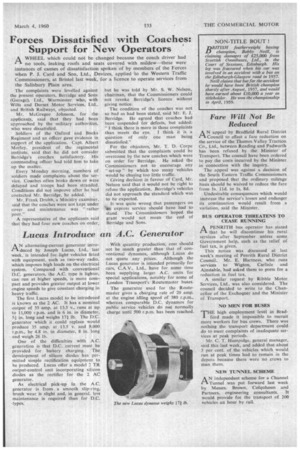Lucas Introduce an A.C. Generator
Page 53

If you've noticed an error in this article please click here to report it so we can fix it.
AN alternating-current generator introduced by Joseph Lucas, Ltd., last week, is intended forlight vehicles fitted with equipment, such as two-way radio, which imposes high loads on the electrical system. Compared with conventional D.C. generators, the A.C. type is lighter, can run at higher speeds, is more compact and provides greater output at lower engine speeds to give constant charging in heavy traffic.
The first Lucas model to be introduced is known as the 2 AC. It has a nominal output of 35 amp. at 13.5 v., runs at up to 11,000 r.p.m. and is 6 in. in diameter, 54in. long and weighs 171lb. The D.C. generator which it could replace would produce 35 amp. at 13.5 v. and 9,000 r.p.m., be 4,8 in. in diameter, 8 in. long and weigh 26 lb.
One of the difficulties with A.C. generation is that D.C. current must be • provided for battery charging. The development of silicon diodes has permitted simple rectification equipment to be produced. Lucas offer a model 2 TR output-control unit incorporating silicon diodes as the rectifier for the 2 AC generator.
As electrical pick-up in the A.C. generator is from a smooth slip-ring, brush wear is slight and, in general. less maintenance is required than for D.C.
• types. With quantity production, cost should not be much greater than that of conventional dynamos, although Lucas do not quote any prices. Although the Lucas generator is intended primarily for cars, C.A.V., Ltd., have for some time been supplying larger A.C. units for special applications, notably for some of London Transport's Routemaster buses.
The generator used for the Routemaster gives a charging rate of 20 amp. at the engine idling speed of 380 r.p.m., whereas comparable D.C. dynamos for public service vehicles do mit normally charge until 500 r.p.m. has been reached.




















































































































